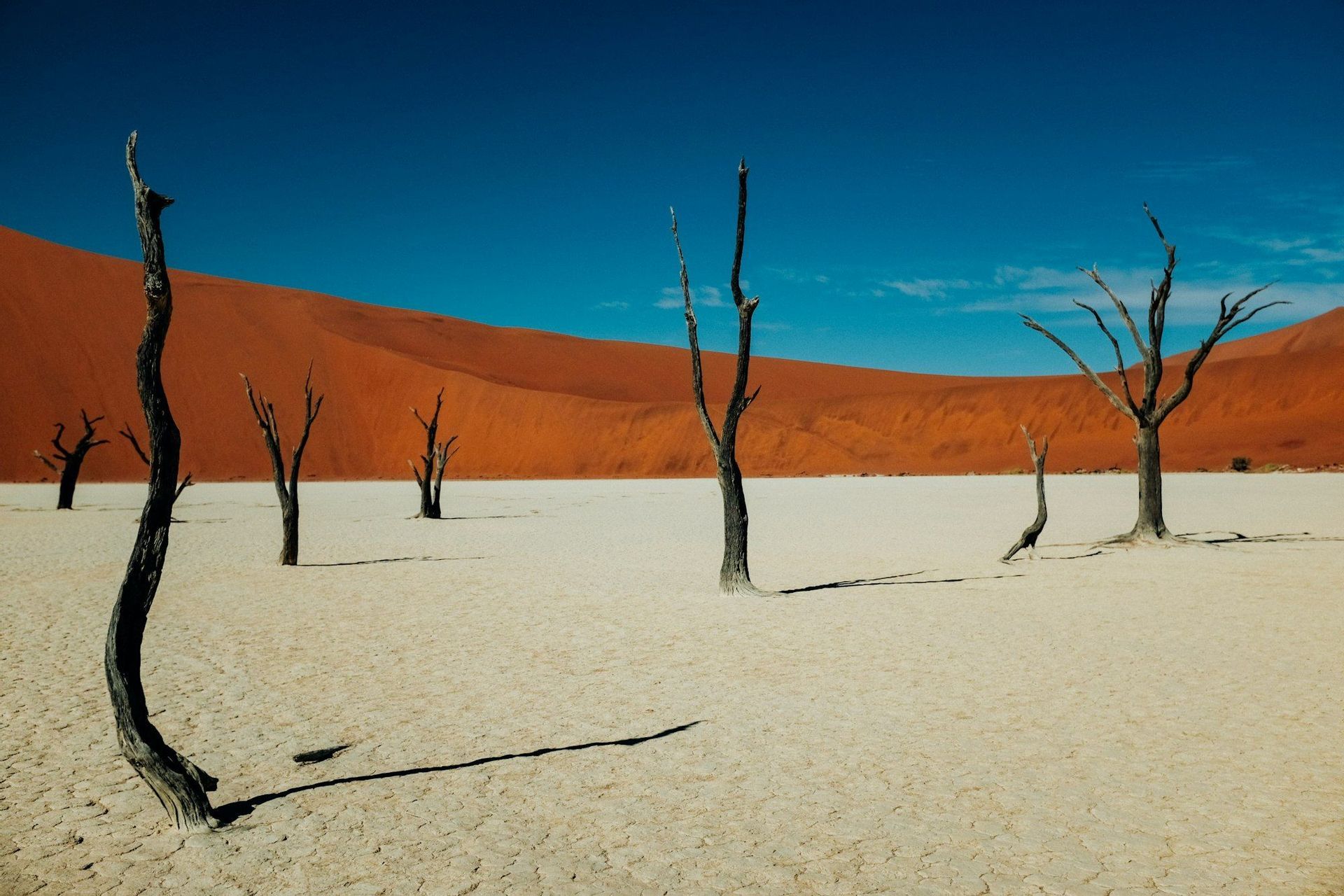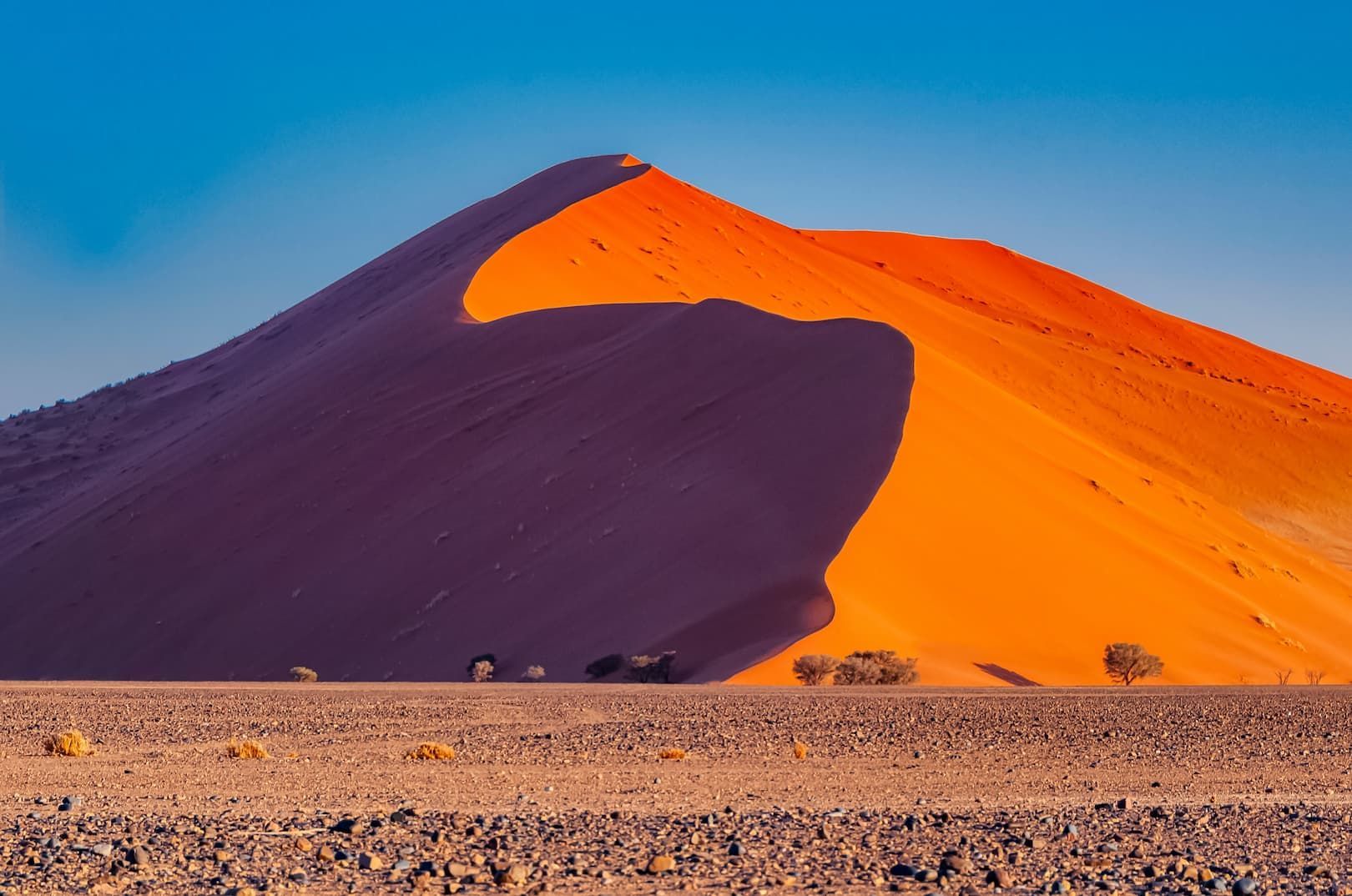
Group trips to Namibia
Our organized trips to Namibia
Journey to a land where ancient silence speaks volumes, and endless horizons unveil a world of unparalleled spectacle. Namibia is a realm of staggering natural beauty and thrilling adventure. From the colossal, burnt-orange dunes of Sossusvlei, carved by winds over millennia, to the ethereal white pans of Etosha National Park, teeming with extraordinary wildlife, it calls to the intrepid explorer, the nature enthusiast, and anyone seeking a profound connection with the planet’s most majestic and pristine wildernesses, promising an experience that transcends the ordinary.
FAQs about Namibia
If you are a UK citizen, to find out the entry requirements for Namibia, you can check this informational page from our partner Sherpa. If you need a visa, you can apply for it through Sherpa. If you are not a UK citizen, you can still use Sherpa by changing the nationality in the 'Passport' section.
Before traveling, always remember to check the government website of your country of origin for updates on the entry requirements for Namibia – you wouldn’t want to stay home due to a bureaucratic detail!
- UK residents: review the FCDO Travel Advice.
- US residents: consult the US Department of State Travel Advice.
- Other residents: refer to your government or local consulate's travel advice.
Namibia operates on Central Africa Time (CAT), which is UTC+2. Namibia does not observe daylight saving time. If it is 12pm in the UK, it will be 2pm in Namibia. If it is 12pm in New York, USA, it will be 6pm in Namibia.
Namibia uses the Namibian Dollar (NAD) as its currency. The exchange rate can vary, but typically:
- 1 GBP equals about 20 NAD
- 1 USD is around 15 NAD
- 1 EUR is roughly 18 NAD
You can exchange currency at banks, exchange bureaus, and some hotels in major cities.
You can pay in Namibia using cash or credit cards. Credit cards like Visa and MasterCard are widely accepted in hotels, restaurants, and larger shops. However, it is good to have some cash for smaller establishments or rural areas where card payment might not be available. ATMs are prevalent in towns and cities, so withdrawing cash when needed is easy. Remember that bank fees may apply when using your card or withdrawing cash, so check with your bank for details.
Tipping in Namibia is appreciated but not compulsory. In restaurants, a 10 to 15 percent tip is generally a nice gesture for good service. For taxi drivers, rounding up the fare is common. If you're on a guided tour, consider tipping your guide and driver separately:
- About 10 to 15 USD per day for the guide
- Around 5 to 10 USD per day for the driver
Remember, tipping is at your discretion and should reflect the quality of service you receive.
In Namibia, Wi-Fi is available in most hotels, cafes, and restaurants in urban areas, but it might not be as reliable or fast as you are used to in Europe or the USA. If you plan to travel to more remote areas, you might consider buying a local SIM card or an e-SIM data plan for more reliable connectivity. Providers like MTC and Telecom Namibia are popular choices and offer good coverage throughout the country. You can purchase a SIM card at the airport or local shops. Make sure your device is unlocked for international SIM use.
In Namibia, the official language is English, so you'll have no problem communicating. However, there are several indigenous languages spoken across the country, including Afrikaans, Oshiwambo, and Otjiherero. Here are some useful expressions you might hear or use:
- Hello: Hallo (Afrikaans)
- Thank you: Dankie (Afrikaans)
- How are you?: Ongaipi? (Oshiwambo)
- Good morning: Morokeni (Otjiherero)
In Namibia, the plugs used are type D and type M, which have three round pins. The electrical voltage is 220-240 volts with a frequency of 50 Hz. If you're coming from a country with different plug types, we suggest bringing a universal adapter to ensure your devices can be used without any issues. Always check your device's voltage compatibility to avoid any damage.
Namibia's main religion is Christianity, with the majority of the population identifying as Christian. Most belong to denominations such as Lutheran, Roman Catholic, and Anglican. While there are no strict religious dress codes, especially for visitors, it's always respectful to dress modestly when visiting religious sites. Important religious holidays include Christmas and Easter, which are widely celebrated across the country.
Packing for Namibia means being prepared for diverse climates, from desert heat to cool evenings. Here's a handy guide to what to put in your backpack:
-
Clothing:
- Lightweight shirts and shorts
- Long-sleeve shirts for sun protection
- A warm jacket for evenings
- A hat for sun protection
-
Shoes:
- Comfortable walking shoes
- Sandals
- Hiking boots if you plan to trek
-
Accessories and technology:
- Sunglasses
- A good camera or smartphone for photos
- A universal adapter for electronics
-
Toiletries and medication:
- Sunscreen
- Insect repellent
- Basic first aid kit
- Common travel medication like pain relievers and antihistamines
Namibia's climate can be extreme, so layering is key, and sun protection is a must.
The weather in Namibia can vary greatly depending on the region:
- Coastal areas: Like Swakopmund and Walvis Bay, the climate is mild with cool, foggy mornings and warm afternoons. The best time to visit is from November to April for warmer weather.
- Desert regions: Such as the Namib and Kalahari deserts, expect hot days and cooler nights. The best time to visit is from May to October when the temperatures are more moderate.
- Northern regions: Like Etosha National Park, it can be very hot, especially from October to December. Visit between May and September for cooler, dry conditions ideal for wildlife viewing.
Remember, Namibia’s seasons are opposite to those in Europe and the USA. Summer runs from November to April, while winter is from May to October.

